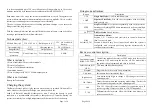
Deprogramming module and re-programming
You must deprogram the system prior to trying to re-program the module. This
system has a fail-safe for digital rectifying that will prevent accidental code storage
thereby creating a secure firing environment..
Step 1. Put the rocket switch to the ( F ) fire position. Turn the key on the receiver
module to “ON” position. Extend the antenna on the module. Ensure that the
transmitter is on.
Step 2. Press and hold the program button. The red LED above the button will
illuminate for about 10 seconds. This LED light will go out when the code is deleted.
It has deleted the previous program. No remote transmitter can control it anymore.
Step 3. Press and release the program button again. Immediately press any channel
button on the remote transmitter. Keep your fingers on the button until you see the
firing LED lights. Which indicates the receiver module has locked onto the signal.
(Warning: Never program the receiver when another transmitter is transmitting. This
may cause the receiver to be programmed with the wrong transmitter.)
Setting the receiver operating mode:
The receiver must be set to the correct mode before using the system. This ensures
that accidentally pressing a button on the transmitter will not have an unwanted
effect.
Mode Display
Screen
Description
Continuous (Same
time Sequencer)
0.01-
9.99second
Sequencer with same time or different time
delay between each cue,
All Fire
ALL
Fires all cues when the ALL button on
transmitter is pressed.
Single Fire
SIN
Fires the correct cue when the button 1-20 is
pressed on the transmitter.
Step STE
Fires the next cue when STEP is pressed on
the transmitter.
To set the receiver operation mode follow the steps below:
1. Hold down OK/DELETE button until the display reads 0.00
2. Press Right-Arrow button to cycle through the digits and operating modes.
3. Press OK/DELETE button to set the correct receiver operating mode.
Expanding the system:
More receivers can be added to expand the system. By programming the receivers
with different transmitter identities, the receivers can be controlled in parallel (at the
same time), individually or a mixture of both.
Example 1. The receivers are programmed with the same transmitter identity so
they are controlled in parallel(at the same time)
1. Program receiver A,B and C with the transmitter slide switch in the same position.
Example 2. The receivers are programmed with same transmitter identity, but
the slide switch not in same position so that they are controlled separately.
1. Program receiver A with the transmitter slide switch in 1 position.
2. Program receiver B with the transmitter slide switch in 2 position.
3. Program receiver C with the transmitter slide switch in 3 position.
Example 3. The receivers can be controlled separately by using the professional
radio control desk KFE2209/18/2.
1. Program receiver A with the control desk rotary switch in 1 position.
2. Program receiver B with the control desk rotary switch in 2 position.
3. Program receiver C with the control desk rotary switch in 3 position.
Example 3. 16 Receivers (16x20=320cues) are programmed with same
transmitter identity in sequence fire mode with different addresses.(Transmitter
slide switch in position 4. Control desk rotary switch in position S)
1. Set the address numbers on each receiver. 1-16.
2. Set the same time delay on each receiver. Example: 0.10 second.
3. Set the communication between the transmitter (or control desk) and the receivers.
Page 5 of 8
Page 6 of 8




